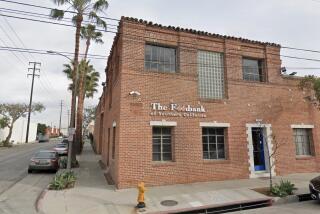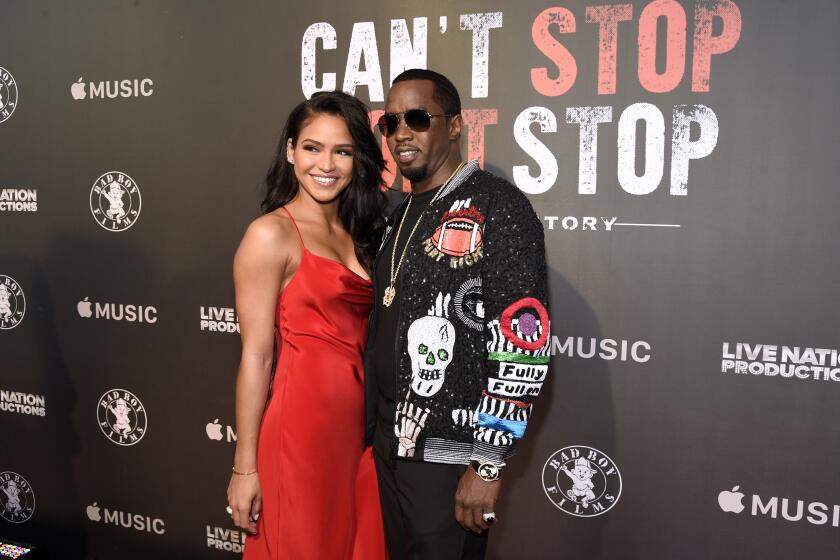COLUMN ONE : Charities Go to War in Workplace : Alternative funds arise to challenge the philanthropic powerhouse United Way. Their growth has been explosive.
- Share via
In tens of thousands of American workplaces, the appearance of United Way pledge cards is an autumn ritual as routine as the end of daylight-saving time. For decades, local arms of the philanthropic powerhouse have enjoyed near-exclusive rights to raising charitable dollars--billions of them--through employee payroll deductions.
But these days, “I gave at the office” can also mean a contribution to Womens Way in Philadelphia, the Northwest AIDS Foundation in Seattle, the Progressive Way in Oakland or the Peace Development Fund in Amherst, Mass.
In California, Oregon and Washington, employees are giving parts of their paychecks to the state Environmental Federation. And in 17 states, workers are having donations to the local Black United Fund subtracted from their wages.
More than 100 of these so-called alternative funds have risen to challenge the central premise that led to creation of United Way-style workplace drives after World War I: that one umbrella group can best serve the interests of both employer and community, by limiting work time devoted to solicitations while efficiently channeling money to a broad spectrum of charitable endeavors.
Officials of the 2,300 local United Way offices across the country still believe that. “We have a good system,” said Jeff Rocke, a spokesman for United Way of Orange County. “We offer a variety of causes that touch a lot of people, and we have a track record.”
Increasingly, however, critics complain that United Way’s good works just do not do enough to attack the multiplying ills of a rapidly changing society.
They concede that traditional United Way beneficiaries, such as the Boy Scouts of America, the American Red Cross and the American Cancer Society, offer valuable services. But organizers of alternative funds say there is still a void and they intend to fill it.
In the process, they have set off charity wars in many cities.
The alternative funds say their narrower focus allows them to take up emerging causes that local United Ways cannot respond to quickly without taking money from their established member agencies. And, they say, they are willing to champion controversial issues that often hold little appeal for the predominantly male, white, corporate membership of many local United Way boards.
“The Anglo population is aging. Our population is much younger,” said Tony Espinoza, who helped organize the fledgling United Latino Fund in Los Angeles. “Our focus is going to be on child care and mothers.”
Karen Campbell, executive director of Seattle’s Women’s Funding Alliance, said, “United Way is not real interested in the ‘L-word’ “--referring to lesbians. And, while the women’s alliance distributes money to organizations that work for abortion rights, the Seattle-area United Way ousted Planned Parenthood as a member agency last year because it planned to offer abortions.
The take of the alternative funds still pales beside the $2.8 billion donated to local United Way offices nationwide last year. Still, their growth has been explosive.
Ten years ago, there were 33 non-United Way funds--15 devoted to social justice and 18 international health-care organizations. They brought in $28 million in worker donations. This fall, by comparison, more than 100 alternative charity funds expect to raise about $105 million.
Today, federal employees have as many as 1,000 choices for their charity dollars, including United Way, alternative funds and even specific social service agencies. Many state and local governments allow workers to select at least one alternative to United Way for payroll deduction. And now the alternative funds are beginning to gain wider access in the private sector.
The alternative funds seem popular with the workers themselves. “Employees ranked choice as their No. 1 motivation for giving,” said Cathie J. Witty, a University of San Francisco researcher who recently finished a study of workplace philanthropy at five Bay Area employers.
But the advance of the “alternatives” has not always proceeded smoothly. Resistance has come from local United Way groups that say their member agencies will suffer if faced with competition, and from employers who fear that multiple charities vying for donations will bring back the confusion of old.
In some cases, alternative funds have gained access to workplaces only after court action, political pressure or endless negotiations.
When Safeway’s Northern California division was considering adding four more choices to its traditional United Way-only charity campaign last year, a delegation from the Bay Area United Way called on the chairman of the Oakland-based supermarket chain to lobby against the additions.
“They were concerned it would drastically affect their campaign,” recalled Debra Lambert, Safeway’s regional coordinator of charity campaigns. But Safeway opened up its campaign anyway.
And when county lawmakers in Seattle were debating whether to grant nine alternative funds the same access that United Way had to 5,000 government employees, United Way asked prominent business figures to lobby to keep the others out.
King County Councilman Ron Sims said he heard from about 30 “heavy hitters. . . . This really touched a nerve.” Sims said United Way agencies sent representatives to plead with him. When it became apparent that King County would open its drive to others, United Way suggested that it should campaign in the fall--traditional charity time--and the alternatives campaign together in the spring.
In the end, none of the strategies worked. King County’s second combined campaign is now under way.
Organizers of the alternatives often say they can coexist with United Way. But many of them also have unkind words for what they see as their opposition.
There is an “arrogance” in the manner in which United Way assumes “it can designate which issues are important,” said Robert O. Bothwell, executive director of the National Committee for Responsive Philanthropy, a Washington-based association for alternative funds.
The first alternative fund was spawned in Los Angeles in the aftermath of the Watts riot of 1965. To funnel charity money into their community, civil rights activists formed the black-oriented Brotherhood Crusade.
They soon realized that merely sponsoring events would not raise enough money to accomplish their goals. They found payroll deduction attractive for the same reasons United Way did: the overhead was low and donors gave larger amounts when the money was subtracted regularly from their paychecks.
The next decision was to concentrate on seeking access to government employees, because they thought they had a better chance of succeeding there.
“There aren’t many minority CEOs of corporations, but there are minorities who are elected officials,” said Brotherhood Crusade President Danny Bakewell Sr. His group now takes in about $1 million a year, mostly from public sector campaigns.
Today there are two new alternative funds in Los Angeles that hope to duplicate the success of Bakewell’s group.
The Asian Pacific Community Fund was created this year by 11 Chinese, Japanese, Filipino, Korean and Southeast Asian service agencies.
Likewise, Latinos have launched their own charity fund. The planning effort began in January and was made public only last month after a series of late-night and pre-dawn meetings held secretly at office buildings around the county.
Next year, the United Latino Fund hopes to approach the Los Angeles County Board of Supervisors for permission to take part in the employees’ charity drive.
Like many of the alternatives, the Latino Fund was born of frustration. Many Latino groups faced hurdles in gaining admission to the United Way of Greater Los Angeles. In fact, no new member agencies have been admitted to the local United Way for three years because fund-raising totals did not grow.
At the time, United Way was seeking volunteer help from Latinos, but that did not satisfy the Latino Fund organizers. “All they did was involve everybody in doing a lot of work, but there still hasn’t been any commitment of money,” said the Latino Fund’s Espinoza.
United Way acknowledges there have been problems. Indeed, an Oct. 10 memo written by an internal task force of Latinos criticized “United Way’s insensitivity to the Hispanic community.” The memo complained that while United Way-funded agencies do serve Latinos, agencies run by Latinos receive little money, which “thus reduces our Hispanic community to a mere poster child for United Way.”
But local United Way officials say the organization is changing. The 113-member board of directors, which was 80% Anglo two years ago, is now 65% Anglo. Ethnic “councils” are recruiting minority volunteers and, this year, Herbert L. Carter, who is black, became the charity’s first minority chairman.
The organization also is re-examining which issues should claim top funding priority. Some of the proposals mirror programs initiated by alternative funds, including the environment and the needs of the city’s immigrants.
The alternatives claim the credit for such shifts. Said Bothwell, of the National Committee for Responsive Philanthropy: “United Way sees not only the foot in the door, but the whole body coming in. They react to the specter of multiple competition.”
Clarence Brown, a spokesman for United Way of Greater Los Angeles, says that the alternative funds are just one of the changes that prompted his group to embark on the first intensive reappraisal in its 25 years of how it dispenses its money. But, he added, “I’m sure they’ve accelerated the process.”
Certainly, local United Way officials are unhappy with the prospect of competing with others for payroll deductions.
“I frankly think there are more productive ways for the alternatives to raise money,” said United Way President Leo Cornelius. “There should be one campaign at the workplace, for the donor’s sake. Otherwise, it’s like watching four or five or 15 TV screens at one time. They need a thoughtful environment to make their choices.”
He pointed out that employees can ask United Way to send money to a non-member agency. But that approach does not satisfy the alternative funds.
Three funds--the Combined Health Appeal, International Services Agency and Environmental Federation of California--filed a $6-million suit last month in Los Angeles Superior Court alleging that United Way’s management of the charity drive among state employees here is unfair.
In a temporary restraining order, a judge told United Way that it cannot distribute pledge cards among state workers in Los Angeles without also giving them information about non-United Way agencies.
Leaders of alternative funds say United Way has nothing to fear from the competition. Bothwell said his committee’s research shows that United Way donations usually increase when alternatives are offered because of heightened interest in charity among employees.
But United Way officials said that conclusion is premature and still needs to be verified.
At some companies, donations have risen but United Way has suffered.
At Safeway in Northern California, for example, total donations increased by 30% with the competitive campaign in 1988, after years of a gradual slide in worker participation, charity coordinator Lambert said. But Bay Area United Way received less than it had in the past, she added.
In Southern California, charitable giving by Laguna Beach city employees went from nearly $14,000 in a United Way-only campaign in 1988 to nearly $17,000 this year when the Environmental Federation was added to the roster, according to Jeff Rocke, a spokesman for United Way of Orange County. But contributions to United Way dropped to about $12,500.
In Seattle, the same thing happened. County employees contributed more money when they had a choice of charities, but United Way got less.
“That shouldn’t matter,” said Councilman Sims. “United Way does great things. They really do great things. But isn’t the important thing how much charitable money flows to the community, not how many dollars are flowing to United Way?”
More to Read
Sign up for Essential California
The most important California stories and recommendations in your inbox every morning.
You may occasionally receive promotional content from the Los Angeles Times.













